Bamboo privacy screens offer unmatched aesthetic appeal with diverse textures and colors while growing up to 30 feet tall in just a few years. You’ll enjoy environmental benefits as bamboo absorbs more CO2 than traditional trees and requires minimal maintenance. Choose clumping varieties like Seabreeze for smaller spaces or cold climates. Beyond visual privacy, bamboo reduces noise pollution and creates effective windbreaks at a lower cost than conventional fencing. The following guide reveals how to select and style your perfect bamboo screen.
The Natural Beauty of Bamboo Privacy Screens
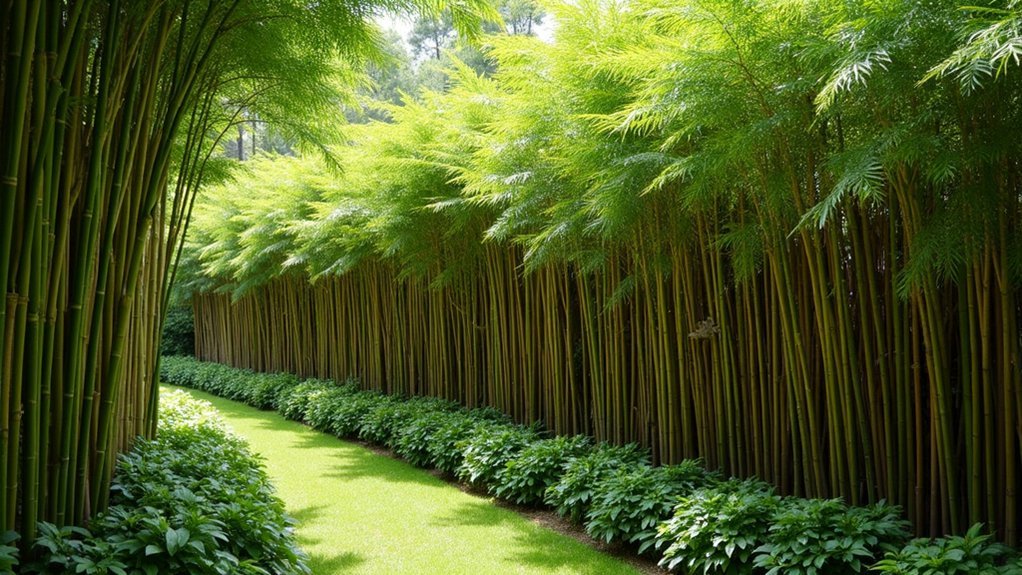
Five distinct qualities make bamboo an exceptional choice for privacy screens in any garden. The visual impact of bamboo’s varied color palette—from classic green to striking black and vibrant red—instantly elevates your landscape’s aesthetic appeal.
You’ll appreciate bamboo’s remarkable growth rate, with some varieties shooting up to 4 feet daily, quickly establishing the privacy screen you desire. The dense foliage doesn’t just block unwanted views but also dampens noise and reduces wind, creating a peaceful sanctuary in your outdoor space.
If you’re concerned about invasiveness, clumping bamboo varieties offer all the privacy benefits without spreading aggressively. These well-behaved plants maintain their designated boundaries while delivering effective screening.
Bamboo’s diverse textures and heights easily complement any garden style, providing a natural privacy screen that harmonizes with your existing landscape elements.
Environmental Benefits of Bamboo Over Traditional Fencing
Bamboo privacy screens offer remarkable environmental advantages over wood fences, with their ability to sequester carbon at rates that exceed most timber species.
You’ll also benefit from bamboo’s extensive root systems that effectively prevent soil erosion on slopes and vulnerable areas in your garden.
Beyond these practical benefits, your bamboo screen will create valuable habitat for local wildlife, supporting biodiversity right in your backyard.
Carbon Sequestration Champion
While many homeowners focus solely on the aesthetic appeal of garden screens, the environmental impact of your fencing choice deserves serious consideration.
When you install a bamboo privacy screen, you’re leveraging one of Earth’s most efficient carbon-capturing plants. Bamboo sequesters carbon at remarkable rates—up to 30% more efficiently than traditional trees, with some species growing an astonishing 4 feet in just 24 hours.
A mature bamboo grove absorbs over 12 tons of carbon dioxide per hectare annually, far outperforming conventional fencing materials.
Unlike wooden fences that contribute to deforestation, bamboo can be harvested without killing the plant, allowing continuous carbon sequestration for years.
Its extensive root systems further enhance this benefit by stabilizing soil and increasing the ground’s carbon storage capacity, making your privacy hedge an environmental powerhouse.
Erosion Control Benefits
Beyond its impressive carbon sequestration capabilities, your bamboo privacy screen offers another remarkable environmental advantage: superior erosion control. When you choose bamboo for privacy, you’re also protecting your landscape from degradation. Unlike traditional fencing that merely stands in place, bamboo’s extensive root network actively stabilizes soil and reduces runoff.
| Bamboo Feature | Erosion Control Benefit |
|---|---|
| Deep root system | Anchors soil in place, preventing movement |
| Rapid growth | Quickly establishes ground coverage |
| Water absorption | Reduces runoff by 30-40% compared to bare soil |
| Dense foliage | Creates natural windbreak, minimizing soil displacement |
The erosion control benefits of bamboo extend beyond your property line, contributing to healthier watersheds. As your bamboo privacy screen matures, it improves soil structure while providing the seclusion you desire.
Biodiversity Habitat Creation
Unlike traditional fencing that merely separates spaces, your bamboo privacy screen transforms into a living sanctuary for local wildlife. The dense foliage provides habitat for birds, insects, and small mammals, creating a thriving biodiversity hotspot in your garden while maintaining privacy.
Bamboo’s thick growth acts as both a windbreak and noise barrier, reducing environmental stress on wildlife and creating protected microhabitats. While conventional fencing disrupts ecosystems, bamboo maintains soil integrity and improves water retention in surrounding areas.
You’ll appreciate bamboo’s resilience in various soil conditions and climate adaptability, ensuring your privacy screen remains vibrant year-round. The plant’s impressive carbon dioxide absorption improves air quality, making your bamboo screen not just a boundary but an environmental asset that supports local ecosystems while serving your privacy needs.
Clumping vs. Running Bamboo: Choosing the Right Variety
When planning your bamboo privacy screen, selecting the right variety can make the difference between a peaceful garden and a neighborhood feud. Clumping bamboo grows in tight clusters up to 5 feet in diameter, offering a manageable alternative to the aggressive running bamboo that spreads through underground rhizomes.
For residential settings, consider these key differences:
- Clumping varieties like Seabreeze and Gracillis create dense privacy screens without invasive spreading.
- Running bamboo requires extensive containment measures to prevent unwanted expansion into neighboring properties.
- Clumping bamboo thrives in smaller yards while still providing effective screening with less maintenance.
While running bamboo grows rapidly, the ongoing maintenance and potential neighbor disputes make clumping bamboo the more harmonious choice for most homeowners seeking privacy solutions.
Height and Density Considerations for Optimal Privacy
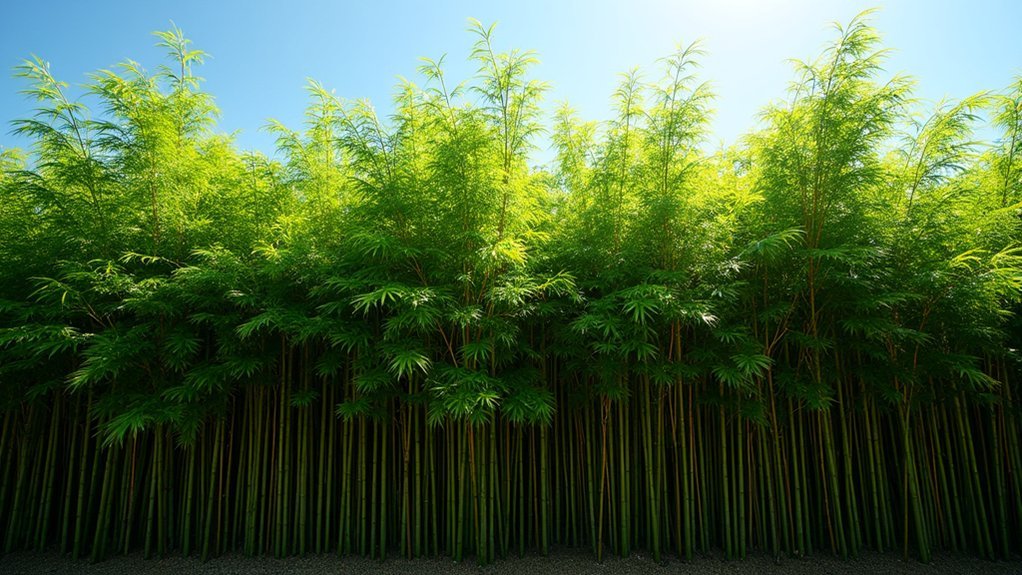
Creating the perfect bamboo privacy screen requires strategic planning of both height and density to achieve maximum seclusion. Bamboo’s impressive growth potential of at least 10 feet makes it an excellent choice for establishing visual barriers in your garden.
For ideal density, consider varieties like Seabreeze or Gracillis that offer lush foliage from ground to tip. These varieties not only block unwanted views but also absorb ambient noise.
Clumping bamboo typically provides superior density for privacy screens compared to running varieties, creating a more solid visual barrier.
You’ll want to space plants 3-5 feet apart for taller varieties to guarantee healthy growth while maintaining adequate density.
Don’t worry about bamboo becoming too tall—regular pruning easily controls height while preserving the privacy benefits you’re seeking.
Climate Adaptability and Hardiness Zones for Bamboo
When selecting bamboo for your privacy screen, you’ll need to match the variety to your climate zone, with cold-hardy Fargesia thriving down to -20°F in northern regions while tropical species require warmer conditions.
You can choose clumping bamboo for colder areas and running varieties for heat-tolerant applications, ensuring your screen remains lush year-round regardless of location.
Though most bamboo prefers consistent moisture, certain drought-tolerant species can succeed with minimal watering, making bamboo privacy screens versatile across diverse climate conditions.
Cold-Hardy Bamboo Varieties
Despite their tropical origins, several bamboo varieties can withstand frigid temperatures, making them excellent privacy screen options even in colder regions.
If you’re looking to establish a cold hardy privacy fence in zones 4-9, Fargesia species should be your top consideration.
These resilient varieties offer practical benefits for northern gardeners:
- Thrive in shaded locations while tolerating temperatures as low as -20°F
- Feature a clumping growth habit that prevents invasive spreading—perfect for contained garden spaces
- Establish best when planted in fall or spring, giving them time to acclimate before extreme weather
For successful cold-hardy bamboo cultivation, guarantee you provide well-drained soil that retains moisture.
This balance is essential for helping your bamboo screen establish strong roots that will withstand harsh winter conditions.
Tropical Species Selection
These tropical bamboo plants reach impressive heights of up to 30 feet within just a few years, establishing dense foliage barriers much faster than traditional hedges.
For best results, plant them in well-drained, fertile soil with adequate sunlight.
Consider clumping varieties such as *Bambusa textilis* (Weaver’s Bamboo) to avoid the spreading issues common with running bamboos.
These clumping species maintain a manageable growth pattern while still providing the lush, tropical aesthetic that makes bamboo an exceptional choice for privacy landscaping.
Drought Tolerance Considerations
Although bamboo is often associated with humid tropical environments, many species display remarkable drought tolerance once established, making them versatile options for privacy screens across various climate zones.
When you plant bamboo, consider your local USDA Hardiness Zone to select varieties best suited for your region’s moisture levels.
- Fargesia species offer superior drought tolerance compared to other bamboos, making them excellent choices for drier climates.
- Properly established bamboo (2-3 years old) requires considerably less water than newly planted specimens.
- Strategic mulching helps retain soil moisture, enhancing bamboo’s natural drought resistance.
For best results, provide consistent watering during the establishment phase, after which your bamboo privacy screen will develop greater resilience to periodic dry spells while maintaining its dense, verdant appearance.
Installation Techniques for Bamboo Privacy Screens
When installing bamboo privacy screens, you’ll need to take several preparatory steps to secure success. First, check your local bylaws to confirm bamboo planting is permitted in your area, avoiding future disputes with neighbors.
Before digging, install a rhizome barrier around your planned bamboo area. This vital installation technique prevents invasive species from spreading beyond your privacy screen.
Plant your bamboo 3-5 feet apart, allowing sufficient space for growth while maintaining proper air circulation.
Choose a location with adequate sunlight and well-drained soil. After planting, water deeply to establish strong roots.
For long-term success, commit to bi-annual maintenance including pruning and fertilizing to keep your privacy screen at the desired height and density.
Containing Bamboo Growth: Barriers and Management Strategies
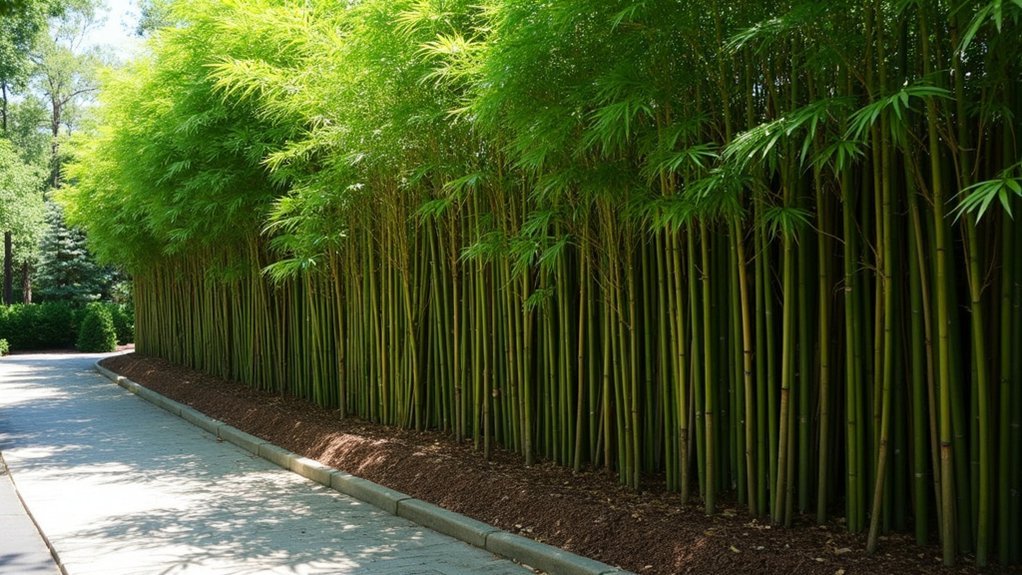
You’ll need to install robust barriers at least 30 inches deep to effectively contain running bamboo, ideally using metal or high-density plastic that prevents rhizomes from escaping.
Regular root pruning around the perimeter will help manage any shoots that attempt to bypass your barriers, requiring vigilance especially during active growth seasons.
While running bamboo varieties demand these strict containment measures, you might consider clumping bamboo instead, which naturally grows in tight clusters and poses considerably less risk of unwanted spread.
Effective Barrier Installation
Because bamboo can quickly spread beyond its intended boundaries, installing proper containment barriers is essential for maintaining a controlled privacy screen.
When creating your green screen, proper barrier installation prevents unwanted spreading while preserving bamboo’s natural beauty. Metal or concrete barriers should extend at least 30 inches deep around your bamboo’s perimeter, with 2-3 inches remaining above ground level to stop surface runners.
For best results:
- Install barriers before planting, ensuring seamless perimeter protection
- Overlap and seal all barrier joints to prevent escape points
- Monitor annually for any shoots attempting to cross your barrier
For clumping bamboo varieties, less intensive barriers may suffice, but running bamboo absolutely requires robust containment.
With effective barrier installation, you’ll enjoy your bamboo privacy screen without worrying about it invading neighboring spaces.
Root Pruning Techniques
Even with proper barriers in place, diligent root pruning forms a critical second line of defense in bamboo management. You’ll need to cut back rhizomes at least annually to maintain control of your privacy screen and prevent unwanted spreading.
When new shoots emerge beyond your desired growth area, sever them immediately with a spade or shovel. This regular maintenance guarantees your bamboo remains within bounds while still providing ideal screening.
| Season | Pruning Action | Benefit |
|---|---|---|
| Spring | Cut new shoots | Controls spread |
| Summer | Trim tops | Encourages density |
| Fall | Inspect barrier | Prevents breaches |
| Winter | Plan expansion | Strategic growth |
| Year-round | Monitor edges | Maintains boundaries |
Root pruning not only contains your bamboo privacy screen but also promotes healthier, denser growth—giving you better screening while preventing neighborhood disputes.
Clumping vs. Running
The fundamental distinction between clumping and running bamboo varieties determines how much effort you’ll invest in maintenance for your privacy screen.
Clumping bamboo grows in tight clusters, staying close to the parent plant and requiring minimal containment efforts—ideal for smaller gardens where space control is essential.
Running bamboo, however, spreads aggressively through underground rhizomes and demands proactive management to prevent invasive growth.
- Install rhizome barriers or metal containers around running bamboo to protect structures and neighboring properties
- Choose clumping bamboo for hassle-free privacy screens that won’t overtake your garden
- Regularly prune new shoots of running bamboo to manage spread and maintain pathways
Understanding these growth patterns helps you select the right bamboo type for your privacy needs while minimizing future maintenance challenges.
Seasonal Care and Maintenance Requirements
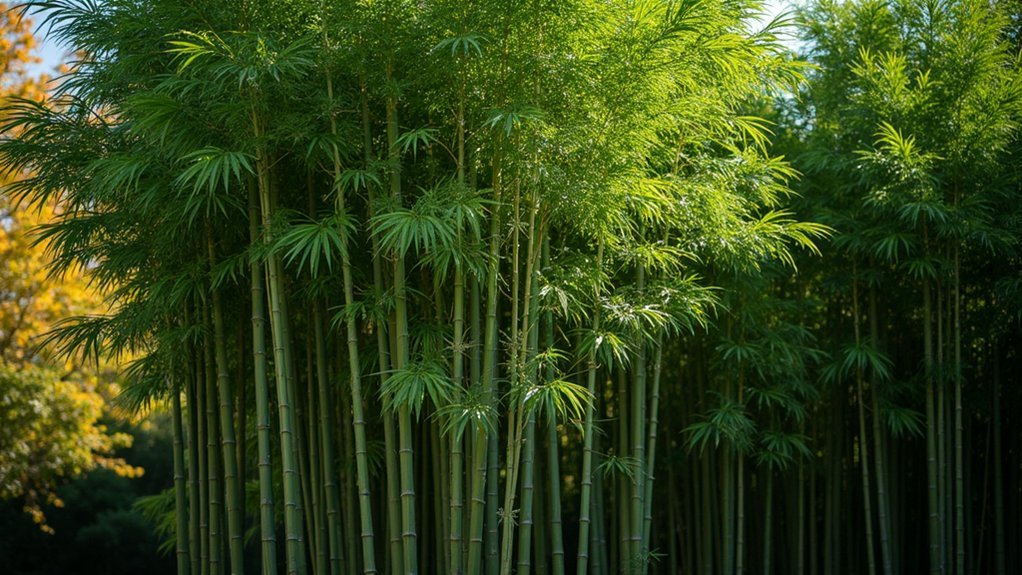
Maintaining your bamboo privacy screen throughout the year requires strategic attention to its changing needs as seasons shift. As one of the fastest growing plants available, bamboo demands regular pruning to preserve its height and vertical structure, with more frequent trimming during peak growth periods.
For peak health, fertilize twice annually with slow-release products—typically in spring and late summer. Your seasonal care should include adjusting watering schedules during dry spells and applying protective mulch in winter months.
Throughout the growing season, regularly inspect your bamboo for signs of stress, disease, or pests that could compromise its screening effectiveness.
Verify your plants receive adequate sunlight and moisture by conducting seasonal assessments of these crucial conditions. These maintenance practices will keep your bamboo screen dense, vibrant and functional year-round.
Combining Bamboo With Other Plants for Enhanced Screening
While bamboo alone creates effective privacy barriers, combining it with complementary plants transforms simple screens into dynamic, layered landscapes that enhance both seclusion and visual appeal.
When you pair different bamboo varieties with carefully selected companions, you’ll create a privacy solution that’s both functional and beautiful.
Consider these strategic plant pairings:
- Mix clumping bamboo with taller ornamental grasses for varied heights and textures that form a natural-looking barrier.
- Combine Seabreeze bamboo with flowering perennials to enjoy seasonal blooms alongside your privacy screen.
- Partner bamboo with evergreen shrubs to guarantee year-round coverage, especially in winter when bamboo density may decrease.
These thoughtful combinations promote biodiversity, creating a resilient garden ecosystem where plants that share similar growing requirements thrive together.
Cost Analysis: Bamboo vs. Traditional Privacy Solutions
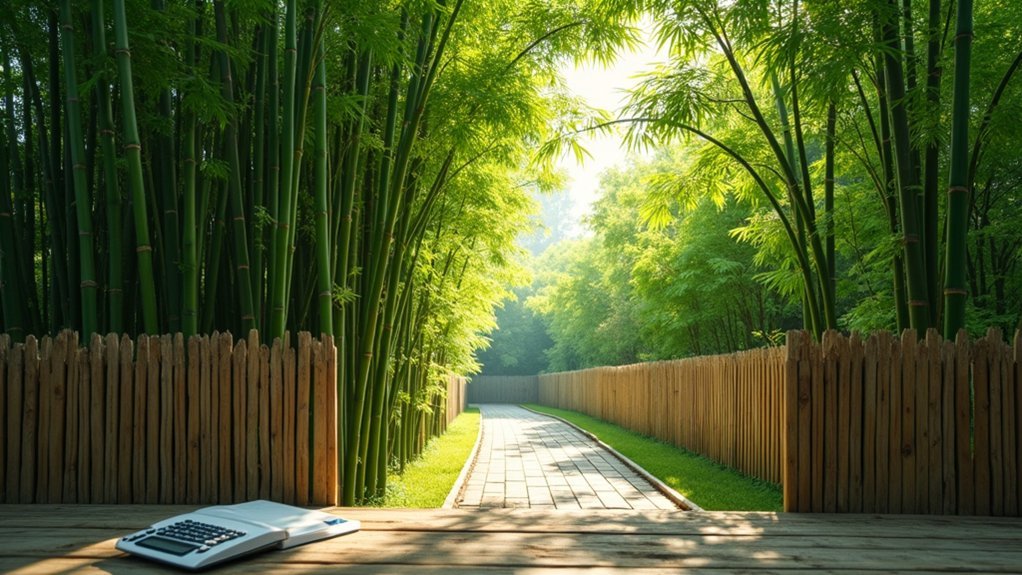
When comparing privacy solutions for your garden, bamboo often emerges as a cost-effective alternative to conventional fencing options.
A thorough cost analysis reveals that while traditional fences require permits, installation fees, and material costs potentially reaching thousands of dollars, growing bamboo typically demands less initial investment.
You can purchase starter bamboo plants for as little as $60, though pre-grown options at 10-30 feet are available at premium prices.
The real savings come over time—bamboo establishes privacy screens in just 3-5 years, whereas traditional fences take longer to install and mature.
Additionally, bamboo’s durability means it thrives for decades with minimal maintenance, unlike fences that often need replacement.
With just basic care and occasional pruning, you’ll enjoy both immediate savings and long-term value.
Noise Reduction and Wind Break Capabilities
Beyond creating visual privacy, bamboo serves as a remarkable natural sound barrier and windbreak for your garden sanctuary.
The dense foliage and thick stems effectively absorb sound waves, reducing noise from busy streets and neighbors by deflecting both low and high-frequency sounds.
You’ll appreciate bamboo’s dual functionality as it protects your outdoor space in multiple ways:
- Dense varieties like Seabreeze and Gracilis create effective screens that maximize noise reduction while maintaining aesthetic appeal.
- Strategic bamboo plantings can decrease wind speed by up to 50%, sheltering delicate plants and creating comfortable outdoor living areas.
- The tall growth pattern provides extensive protection, addressing both ground-level and elevated disturbances.
This natural solution outperforms many artificial barriers while enhancing your garden’s tranquility and sustainability.
Legal Considerations and Neighbor Relations
As bamboo creates your peaceful garden sanctuary, it can simultaneously generate tension with those living nearby. Before planting, research local ordinances that may restrict invasive bamboo varieties in your area. Many municipalities have enacted regulations specifically addressing bamboo due to its potentially aggressive growth patterns.
Prioritize clear communication with neighbors about your bamboo plans. Explain which variety you’re planting (preferably clumping rather than running types) and your maintenance strategy. This proactive approach prevents misunderstandings and demonstrates goodwill.
Remember that HOAs often don’t effectively police bamboo-related disputes, leaving you to manage neighbor relations personally. Should a neighbor’s bamboo encroach on your property, legal remedies are typically limited, making prevention through communication even more valuable.
Choose clumping bamboo varieties and install proper barriers to maintain both privacy and neighborly harmony.
Design Inspiration: Styling Your Bamboo Privacy Screen
Creating a striking bamboo privacy screen involves much more than simply planting a row of stalks. Your bamboo can become a stunning design feature that reflects your personal style while providing the privacy you desire.
Consider these styling approaches:
- Mix bamboo varieties like Seabreeze and Gracilis to create visual depth—clumping varieties offer particularly dense foliage that blocks both sightlines and noise effectively.
- Express yourself through color choices—bamboo screens come in green, yellow, black, and red tones that can complement your existing garden palette.
- Transform your privacy solution into vertical art by training bamboo as a trellis for climbing plants.
With bamboo’s impressive growth rate, you’ll achieve your designed privacy screen within 3-5 years, creating a lush, textured backdrop that’s both functional and aesthetically pleasing.
Frequently Asked Questions
Does Bamboo Make a Good Privacy Screen?
Yes, bamboo makes an excellent privacy screen. You’ll appreciate its fast growth, reaching 10-30 feet quickly. It’s dense, provides wind protection, and with clumping varieties, you won’t worry about invasive spreading.
Why Is It Illegal to Grow Bamboo in the US?
Bamboo isn’t illegal nationwide in the US. You’ll find restrictions in some areas due to concerns about invasive species, particularly running bamboo varieties. Check your local ordinances before planting to avoid potential fines or neighbor disputes.
What Is the Downside of Bamboo?
Bamboo’s downsides include invasive spreading through aggressive rhizomes, high maintenance needs, potential property damage, neighbor disputes, and costly removal. You’ll face ongoing containment challenges as it can encroach on structures and neighboring yards.
What Is the Best Bamboo for Garden Screen?
For the best garden screen bamboo, you’ll want clumping varieties like Seabreeze, Gracillis, or Blue Chungii. They’re non-invasive, grow in tight clusters, and create effective privacy without aggressive spreading. Seabreeze is particularly excellent for dense screens.
In Summary
You’ll find bamboo privacy screens offer unmatched natural beauty while being environmentally responsible. Whether you choose clumping or running varieties, bamboo provides excellent height, density, and noise reduction that traditional fencing can’t match. It’s adaptable to various climates and often more cost-effective long-term. Remember to check local regulations before planting, but with proper design, you’ll create a stunning, sustainable boundary that enhances your outdoor sanctuary.

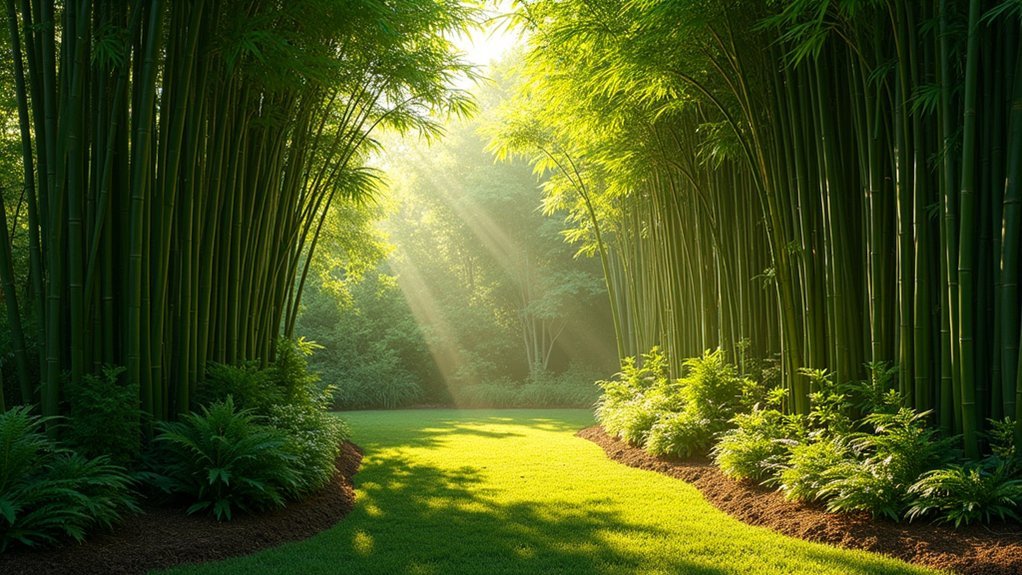



Leave a Reply